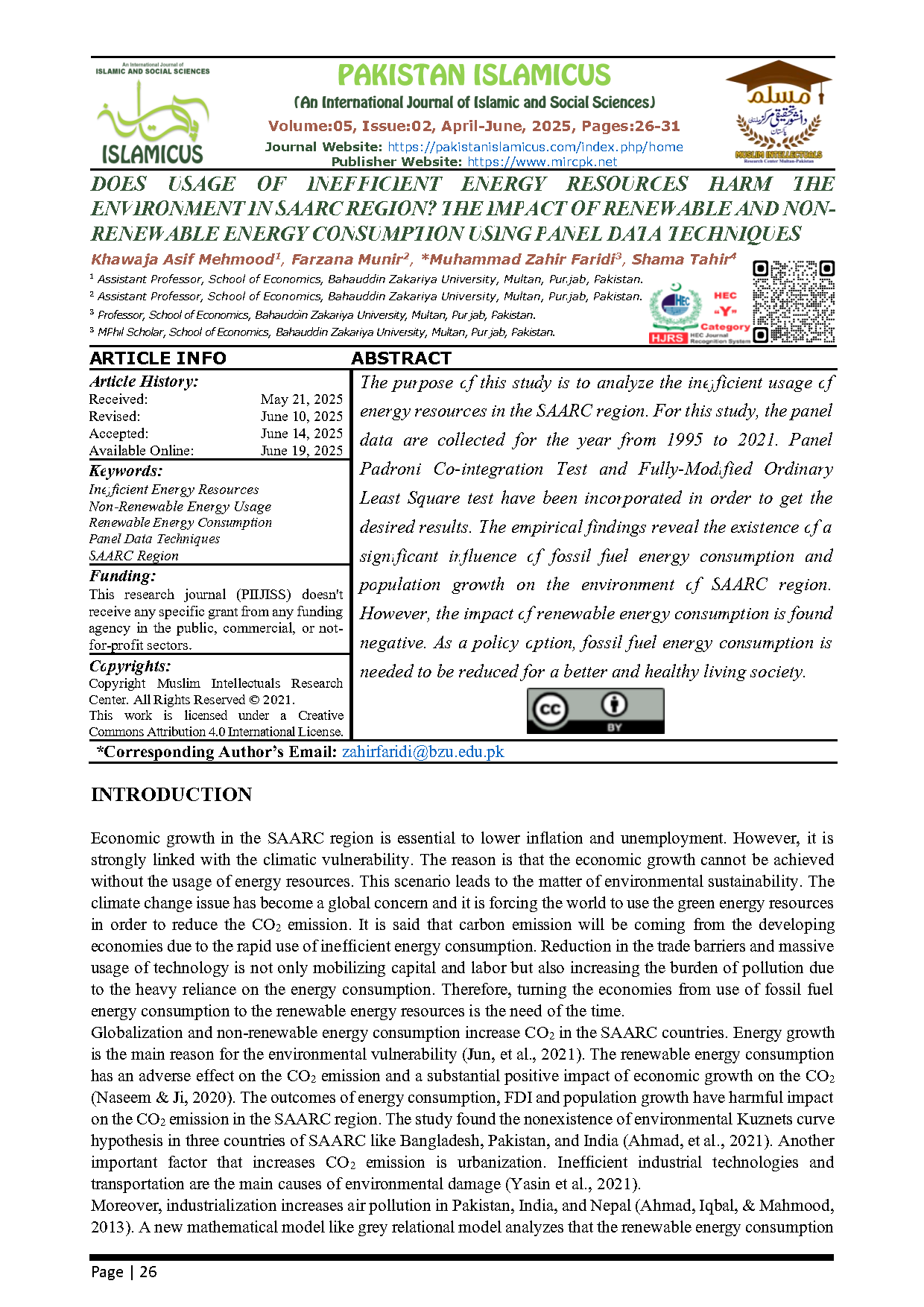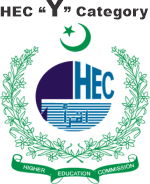DOES USAGE OF INEFFICIENT ENERGY RESOURCES HARM THE ENVIRONMENT IN SAARC REGION? THE IMPACT OF RENEWABLE AND NON-RENEWABLE ENERGY CONSUMPTION USING PANEL DATA TECHNIQUES
Keywords:
inefficient energy resources, non-renewable energy usage, renewable energy consumption, panel data techniques, SAARC RegionAbstract
The purpose of this study is to analyze the inefficient usage of energy resources in the SAARC region. For this study, the panel data are collected for the year from 1995 to 2021. Panel Padroni Co-integration Test and Fully-Modified Ordinary Least Square test have been incorporated in order to get the desired results. The empirical findings reveal the existence of a significant influence of fossil fuel energy consumption and population growth on the environment of SAARC region. However, the impact of renewable energy consumption is found negative. As a policy option, fossil fuel energy consumption is needed to be reduced for a better and healthy living society.
References
Adebayo, T. S., & Kirikkaleli, D. (2021). Impact of renewable energy consumption, globalization, and technological innovation on environmental degradation in Japan: Application of wavelet tools. Environment, Development and Sustainability. 23(2021), 16057-16082.
Ahmad, A., Gill, A. R., Usman, M., Muhammad , A., Haider, S., & Almas, L. k. (2021). Transport energy consumption and climatic challenges in SAARC countries. Indian Journal of Economics and Business, 20(4). 1863-1880.
Ahmad, N., Iqbal , A., & Mahmood, H. (2013). CO2 emission, population and industrial growth linkages 2 in selected South Asian countries: A Co-integration analysis. Worls Applied Sciences Journal, 21(4), 615-622.
Ahmed, K., & Long, W. (2012). Environmental Kuznets curve and Pakistan: An empirical analysis. Procedia Economics and Finance, 1(2012), 4-13.
Akhmat, G., Zaman, K., Shukui , T., Irfan , D., & Khan, M. M. (2014). Does energy consumption contribute to environmental pollutants? Evidence from SAARC countries. Environ Sci Pollut Res., 21(9), 5940-5951.
Anser, M. K., Wasim, S., Aziz, B., & Wasim, S. (2020). Impact of urbanization, economic growth, and population size on residential carbon emission in the SAARC countries. Clean Technologies and Environmental Policy, 22(2020), 923-936.
Azam , M., & Khan, A. Q. (2016). Urbanization and environmental degradation: Evidence from Four SAARC countries-Bangladesh, India, Pakistan, and Sri Lanka. Environmental Progress & Sustainablility Energy, 35(3), 1-10.
Bakar, N. A., Raji, J. O., & Farooq, R. M. (2019). Greenfield, mergers and acquisitions, energy consumption, and environmental performance in selected SAARC and ASEAN countries. International Journal of Energy Economics and Policy, 9(2), 216-224.
Ikram, M., Zhang, Q., Sroufe, R., & Shah, S. Z. (2020). Towards a sustainable environment: The nexus between ISO 14001, renewable energy consumption, access to electricity, agriculture and CO2 emission in SAARC countries. Sustainable Production and Consumption, 22, 218-230.
Jun, W., Mughal , N., Zhao, J., Shabbir, M. S., Niedbala, G., Jain, V., & Anwar , A. (2021). Does globalization matter for environmental degradation? Nexus among energy consumption, economic growth, and carbon dioxide emission. Energy Policy, 153, Retrieved from: https://doi.org/10.1016/j.enpol.2021.112230
Khalid, K., Usman, M., & Mehdi, M. A. (2020). The determinants of environmental quality in the SAARC region: a special heterogeneous panel data approach. Environmental Scienece and Pollution Research, 28, 6422-6436.
Latief, R., Kong, Y., Javeed, S. A., & Sattar, U. (2021). Carbon emissions in the SAARC countries with causal effects of FDI, economic growth and other economic factors: Evidence from dynamic simultaneous equation models. International Journal of Environmental Research and Public Health, 18(9), 1-22.
Mustafa, K., Shah, M., Khan, N., Khan, R., & Khan, I. (2007). Resource degradation and environmental concerns in Pakistan’s agriculture. Sarhad J. Agri, 23(4), 1159-1168.
Naseem, S., & Ji, T. G. (2020). A system-GMM approach to examine the renewable energy consumption, agriculture and economic growth's impact on CO2 emission in the SAARC region. Geo Journal, 86, 2021-2033.
Pandey, S., & Mishra, M. (2015). CO2 emissions and economic growth of SAARC countries: Evidence from a panel VAR analysis. World Journal of Applied Economics, 1(2), 23-33.
Rahman, M. M., Ahmed, R., Mashud, A. H., Malik, A. I., Miah, S., & Abedin, M. Z. (2022). Consumption-based CO2 emission on sustainable development goals of SAARC region. Sustainability, 14(3), 1-27.
Rasiah, R., Guptan, V., & Habibullah, M. S. (2018). Evaluating the impact of financial and economic factors in environmental degradation: A panel estimation study of selected ASEAN countries. International Journal of Energy Economics and Policy, 8(6), 209-216.
Rehman, H. U., & Zeb, S. (2020). Determinants of environmental degradation in economy of Pakistan. Empirical Economic Review, 3(1), 85-109.
Sujith, J. (2019). Experiential EKC: Trade openness for optimal CO2 emission in SAARC region (Munich Personal RePEc Archive). Retrieved from: https://mpra.ub.uni-muenchen.de/93203/
Wang, J., Hassan , M. S., Alharthi, M., Arshed, N., Hanif, I., & Saeed, M. I. (2021). Inspecting non-linear behavior of aggregated and disaggregated renewable and non-renewable energy consumption on GDP per capita in Pakistan. Energy Strategy Reviews, 39(2022), 1-12.
Waqih, M. A. U., Bhutto, N. A., Ghumro, N. H., Kumar, S., & Salam, M. A. (2019). Rising environmental degradation and impact of foreign direct investment: An empirical Evidence from SAARC region. Journal of Environmental Management, 243, 472-480.
Xue, L., Haseeb , M., Mahmood, H., Alkhteeb, T. T., & Murshed, M. (2021). Renewable energy use and ecological footprints mitigation: Evidence from selected South Asian economies. Sustainability, 13(4), 1-20.
Yasin , I., Ahmad, N., & Chaudhary, M. A. (2021). The impact of financial development, political institutions, and urbanization on environmental degradation: Evidence from 59 less-developed economies. Environment, Development and Sustainability, 23, 6698-6721.

Downloads
Published
Issue
Section
License
Copyright (c) 2025 PAKISTAN ISLAMICUS (An International Journal of Islamic & Social Sciences)

This work is licensed under a Creative Commons Attribution 4.0 International License.
This work is licensed under a Creative Commons Attribution 4.0 International License.

































